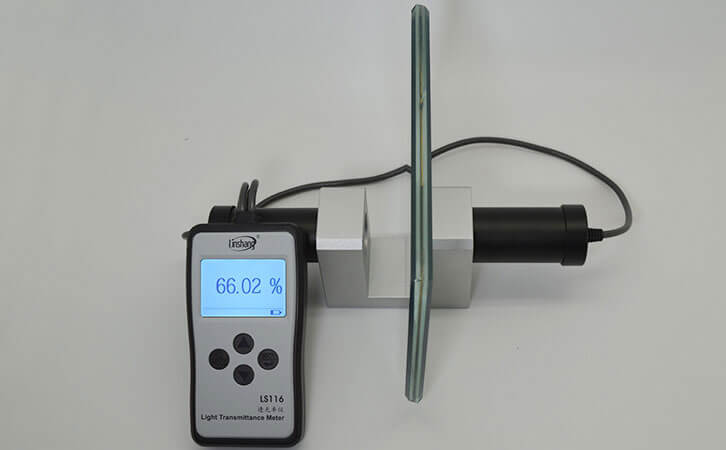Factors Affecting Glass Transmittance and Transmittance Test
1. Definition of glass transmittance
Percentage of the luminous flux of light passing through a transparent or translucent body and its incident luminous flux.
2. Light transmission of glass
When light enters the glass from a certain angle, reflection, absorption and transmission occur. When light enters the glass and then reflects out of the glass at a certain angle, this phenomenon is collectively called reflection. It is reflected in the form of reflectivity. The nature of light passing through glass is commonly referred to as transmission, which is mainly reflected in the form of light transmittance. After the light passes through the glass, it will cause a local loss of light energy. This phenomenon of light energy loss is called absorption, which is reflected in the form of absorption rate. The average transmittance of ordinary daylighting glass is slightly higher than 80% on average; the heat-reflective glass used for shading and heat insulation has relatively higher reflectance requirements;
3. Factors affecting the clarity of glass transmittance
(1) Substrate: Of course, the good substrate can greatly improve the clarity of the front glass film, but the price will be relatively high.
(2) Adhesive layer: Because each automotive film brand has a different coating process, it will cause uneven application of the adhesive layer, which will cause ripples. If you look at these ripples for a long time, you will have headaches and dizziness. accident.
(3) Production process: Higher automotive film is usually sputtered, so the sharpness of the manufactured automotive film will be very high. And if the car film that only adopts the manufacturing process of applying heat-absorbing powder will reproduce a slight blur, the car film will turn yellow in about 2 years.
(4) Internal and external reflectance: Of course, the lower the internal reflectance of the car film, the better. Once the reflectance is high, the phenomenon inside the car will be projected on the glass; People sitting in the car feel suppressed and watching the scenery outside the car will be affected. Looking outside the car, the highly reflective film looks like a mirror. Generally speaking, the reflectivity of metal films is high. The transmittance value measured by the transmittance meter is above 15% and the majority is 20% -40%. Of course, it is not complete. There are some front-end reflections of metal solar films. The rate is also good, the higher the metal gloss, the stronger the reflectivity. The reflectivity of non-metallic films is generally low, such as ceramic films, dyed films and endothermic films. The appearance of ceramic films is better.
4. Measurement of glass transmittance
Transmittance meter, as a professional equipment for material transmittance detection, is widely used in the transmittance test of various transparent and translucent materials such as glass and plastic. Linshang LS116 high-precision transmittance meter is mainly used for transmittance detection of glass products. The instrument uses a white light source that complies with the CIE photopic luminosity function and a parallel light path design, so that the accuracy of this light transmittance meter can reach ± 1%. The Linshang LS116 high-precision transmittance metercan be said to be the highest-precision portable high-precision transmittance meter on the market, for several reasons:
(1) The use method is very simple and the measurement is fast. The resolution can reach 0.001%.
(2) There are two test methods: fixed base measurement and field measurement (the probe has its own magnetic force and the probe can be removed to test large thickness materials)
(3) High-precision, 100mm thick material can be tested
(4) Make sure to pass the test of Chinese National Metrology Institute
(5) Powered by 4 AAA batteries
- Linshang Insulated Glass Unit Measuring Tools
- Spectacle lens anti-blue light detection---blue-violet light transmittance meter
- Measurement of Optical Density
- Difference of LS116 Transmission & LS117 OD Meter
- Difference between LS116 and LS117 Light Transmittance Meter
- What’s the Difference Between Point Light and Parallel Light Transmittance Meter
